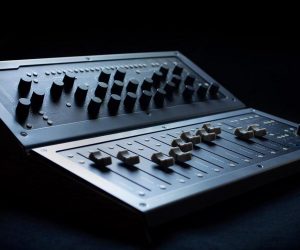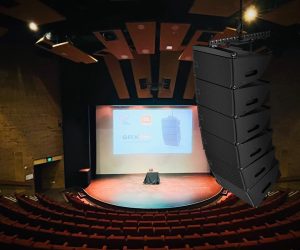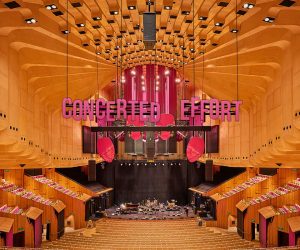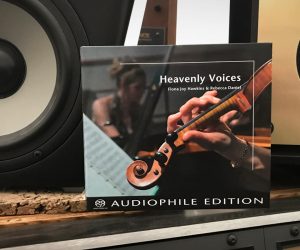
Riding the Waifs
James Newhouse shipped half his Reel2Real Studios coast to coast to record The Waifs in a half-finished house.
Story: Graeme Hague
Some bands seem to come and go in the blink of an iTunes download, others — like The Stones — appear immortal and hang around forever. Then there are bands that quietly carry on making good music for a dedicated fan base — and before you know it you’re asking, “Seriously? They’ve been together that long?”
In 2017 The Waifs celebrate 25 years in the music business. In that time they’ve produced just eight albums, which isn’t a lot, but The Waifs’ early years involved a lot of promotional touring, including a support gig for Bob Dylan in the US. Lately, it’s been more of a logistics issue. The band’s three members — Joshua Cunningham, Vikki Thorn and Donna Simpson (Vikki and Donna are sisters) — are spread across the globe; a very long way from their roots in Albany, Western Australia.
It took almost two years of planning to reunite everyone at Joshua’s half-finished house near Bateman’s Bay on the NSW coast for their latest album, Ironbark. With the group’s 25th anniversary in mind, on the to-do list was a solid month of writing and recording the album.
Ah… half-finished house. Surely, we’re talking about some cool, near-complete uber project studio with state-of-the-art equipment? Nope, Joshua has spent 12 years building a new home from recycled and eco-friendly material, and while the open spaces of an empty house (it didn’t even have a proper kitchen yet) allowed for some creative acoustic treatment, it’s hardly Abbey Road Studios. Not only was the band — along with long-time collaborators David MacDonald (drums and percussion) and Ben Franz (double bass, pedal steel) — travelling from all corners of the planet, they were meeting at a place without a stick of proper recording equipment or someone to operate anything should they get some. Joshua’s home is big on solitude, peace, inspiration and a great vibe, and has over the years become a spiritual home for The Waifs, but the nearest thing he owns to a Pro Tools rig is a four-slice toaster.
TEA-ING UP THE GIG
Obviously, one of the first problems to solve was how to record the music and who can run the gear? James Newhouse first met The Waifs in 2015 when he mixed FOH for part of a regional tour because their regular technician had other commitments. James is also the owner and operator of Reel2Real Studios, which he’s recently relocated from the Big Smoke of Perth to a rural property 200km south (Margaret River wine region is almost a gargle and spit down the road). As the studio name implies, James is a fan of tape machines and all things analogue.
One day, during another WA tour, Joshua Cunningham dropped by for a cuppa and kind of mentioned The Waifs were planning a new album. James kind of mentioned he’d be interested in being involved. Six months later The Waifs’ management got in touch and James got the gig of recording the band’s new album. Maybe he put something in the tea?
Some gig. A recording session in the bush, five hours from Sydney, without a skerrick of recording equipment in sight.
James spent about a week investigating the possibilities of hiring or buying all the necessary equipment — just about everything, remember — to convert the house into a viable recording facility. However, the long distance from any production hire companies, the projected four-week time span of the sessions, and the sheer bits-and-pieces list of stuff required, all combined to make renting uneconomical when compared with the cheaper, but daunting prospect of freighting a large lump of Reel2Real across the country. Aside from Joshua sourcing bog-standard things like microphone stands and cables, ultimately James had to lick enough postage stamps and buy enough bubble wrap to transport 350kg of gear across the Nullarbor.
It wasn’t absolutely everything from Reel2Real, and choosing what to take and what to leave behind revealed a hidden benefit. For instance, with the recording space being largely untreated and without a familiar, accurate monitoring space, James decided there was little point in including boutique equalisers and compressors. The circumstances forced more of a bare-bones approach to the recording process, which in turn provided system stability and any silly, “too much to choose from” delays.
At the signal end of everything was James’ own Mac-based Pro Tools DAW. Preamps amounted to a combination of 80 Series Heritage Audio 1073s, some classic APIs, Rupert Neve and Midas pres. For most of the project (some sparse overdubs were done later) each song was kept under 16 channels. Many of them required a lot less with James aiming for limited microphone placements to avoid spill, and only pursuing natural tones.
This was in keeping with the band’s intention, as always, to record the majority of the tunes live. The Waifs are well-known for their intimate, folk music style, a sound they’ve often created by gathering in a single room and playing together, including tracking final vocals — but that’s easy for them to want, right?

NEWHOUSE PLAN
While the band workshopped songs, James spent the first week examining the house’s various spaces, unpacking his gear and experimenting with different setups. While the house’s large, open-plan design offered plenty of room, and the 10m-high ceilings provided an almost church-like ambience, the best recording space happened to be what will one day be the kitchen, albeit with some interesting reverb issues. Heavy theatre drapes were hung from a balcony, and some second-hand office partitions were strategically placed around the room. Spill was always going to be a problem whenever the full band was in swing, so James shuffled The Waifs’ members about and pointed them in different directions, and microphones were tweaked and swapped until the best possible result was found. Building beds in isolation wasn’t even considered. The magic of The Waifs is very much about the band interacting with each other.
While the days started at 10am and went late into the night, most of the songs were actually recorded on the third or fourth take. A lot of time was devoted to meeting the challenge each session presented when tracking different combinations of acoustic instruments.
The worst-case scenarios (for want of a better term) were songs with the full band; drums, double bass, two acoustic guitars, and three vocals. Makeshift baffles were placed around David MacDonald and Ben Franz, and thankfully neither was averse to any kinds of drastic measures to reduce spill. David even agreed to the ol’ “tea-towel on the cymbals” trick to keep noise levels down. Microphone choice, polarity patterns and placement became critical. Sometimes getting the rejection side of an instrument microphone pointing in the right direction was more important than the live side.
HARMONIOUS BLEND OF MICS
The Waif’s three distinctive vocals creates their unique blend of harmonies. The right microphone selection was essential and fortunately James packed a ‘passable’ box of goodies. Joshua used a Bock 251, Donna a vintage Neumann U67, and Vikki sang into a Pearlman TM1. Calrec pencil microphones turned out to be the workhorse around the snare, tom drums and guitars, with a ribbon mic placed at a distance from the kick drum — which in many songs was an old suitcase. Calrec overheads on the drum kit came into greater use when David took on more of a percussionist role, playing with his hands, using shakers, and the like. The double bass had an EV 635 wedged in a piece of foam and jammed under the bridge so Ben could move around, and an Oktava pencil condenser lurking nearby to catch some right-hand finger-click.
What’s missing here is any form of DI box or wired pickup. Every channel was serviced by a microphone. One of the reasons for that, apart from the vital Waifs live vibe that James was determined to translate into the recordings, is that Joshua makes his own acoustic guitars and they have a wonderful sound that only a microphone will reproduce.
Towards the end of the recording sessions the band moved upstairs to an even more live room and tracked some of their stripped-back, acoustic songs with only a mid/side microphone configuration, using the vintage U67 (mid) in tandem with the Bock 251 (sides). Everyone gathered around, including the double-bass and some percussion and balanced themselves through the microphones.
One of the things that didn’t make the trip over from Western Australia was any kind of studio monitoring system. Joshua had some no-name speakers for the band to hear playback, but the only critical monitoring gear was James’ trusty Sennheisser HD600 headphones — which may seem a trifle risky with all the effort put into deciding microphone choices and positions — but James was confident about his familiarity with the HD600s and felt sure he could hear the slightest variations. There was no time spent on creating any kinds of mixdowns — that was scheduled for later, back at Reel2Real home base. Also, it would have eaten seriously into recording time; this was all about getting tracks down.
James had to lick enough postage stamps and buy enough bubble wrap to transport 350kg of gear across the Nullarbor

BACK OUT WEST
Finally, James packed up his gear, stuffed three hard drives of audio data into his back pocket and flew back to WA. The Waifs scattered around the planet again.
In the four weeks they had recorded 31 songs, which were culled back to 25. From the beginning, there was no real plan as to how much material would be created, just a rough concept of “12 or 13” songs that grew into a double CD. By the way, don’t be fooled by the ‘25th Anniversary’ timeline. Ironbark isn’t a collection of re-recorded best-of tunes; every song is a new composition.
From his home base, James started distributing rough mixes to the band for feedback. James made the decision to record at 24-bit/96k some time back and he said it made a real difference to The Waifs’ recordings. With the very live, open microphone approach to the sessions and the considerable space in the recordings, the higher sample rate was significant in capturing the scope of sound.
Another deliberate departure from his past workflow was the use of UAD plug-ins to simulate tape instead of the tape machines sitting in the corner of Reel2Real’s control room. Of course, it would have been totally impossible to ship the tape recorders across the country anyway, but regardless James has finally succumbed to admitting the impracticalities of using tape — not to mention maintaining the machines — when quality plug-ins come so close to reproducing the same sound, plus you get the speed of staying in the digital domain. It’s a choice that had no bearing on James being asked to record Ironbark (and also score production credits), just don’t tell anyone so he can keep the studio name.
Joshua travelled to WA to have input in the final mixdowns, and took the opportunity to sneak in a few overdubs — James had presciently grabbed a convolution of the recording space to ensure nothing sounded out of place. However, overall the songs stayed the live, raw productions the band always wanted with minimal effects. Once the mixes were locked down, they were sent away to William Bowden for mastering.
HOUSE BUILT ON HARD YARDS
For a lot of musicians this story must sound a lot like living the dream. A grand house (albeit without any proper furniture) in the countryside, hi-tech recording equipment on call 24/7, a whole month to polish and record your latest songs, nobody but the band and the sound engineer living there… what’s not to like?
You have to acknowledge the many years of hard work The Waifs have put in that’s brought them to this point in the band’s career. Four years of touring in a Kombi van for starters — it’s surprising they didn’t kill each other during the 1990s. Even when success began knocking at the door, The Waifs still did a million kilometres and played countless stages. They’ve done more than their fair share of hard yards.
So how long does it take, before any band can enjoy a four-week escape to the countryside and record a new album?
About 25 years.
















RESPONSES